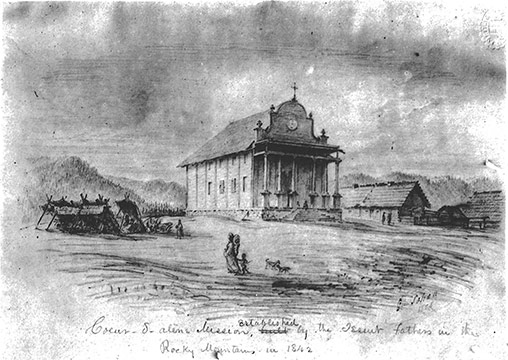Father Point had been two years with the Coeur d’Alènes. He had arrived there the first Friday of the month and, on that day, had placed the mission under the protection of the Sacred Heart. “From that moment,” he writes, “a Christian spirit animated the inhabitants of this happy valley. The nightly gatherings, sacrilegious ceremonies, and diabolical apparitions formerly so frequent, have now been done away with. Gambling, hitherto the absorbing occupation of the Indians, has also been abandoned. Marriage, which for centuries knew neither unity nor indissolubility, has been restored to its pristine purity. From Christmas until the feast of the Purification, the missionary’s fire was made with the remains of their sorcery.”

“Coeur d’Alene Mission in 1842” by Gustav Sohon. The mission was named after the Sacred Heart of Jesus.
When Father Point arrived at the mission, he had drawn the plan of the village, and the Indians had set to work to fell trees, dig ponds, make roads, and till the soil. A church was erected in the center of the settlement, and the religious celebrations acquainted the new converts with the solemnity and appeal of the new faith.

Though the Coeur d’Alene tribe had few materials to decorate the church, they used ingenious techniques to beautify it. The walls were decorated with fabric bought from the Hudson’s Bay Company and hand-painted newspaper from Philadelphia that Fr. Ravalli had received in the mail. Tin cans were used to create an idea of chandeliers. Both wooden statues were carved by hand by Fr. Rivalli with nothing but a knife and were intended to look like marble. The blue coloring of the interior wood is not paint but a stain created by pressing local huckleberries into the wood.
Father Joset, who came shortly to share Father Point’s labors, was destined to pass many years of fruitful apostolic work in the mountains. The neophytes’ fervor daily increased, and Father Point tells us that “For several months not one grave offence has been committed in the Sacred Heart village, at least not among those who have received baptism.”

Built in 1843, without nails by three Jesuit Priests with the assistance of the Coeur D’Alene Indians. The Church of the Sacred Heart, also known as the Cataldo Mission or simply the Old Mission, is Idaho’s oldest standing building.
The faith and piety of this mission was due in large measure to Louise Sighouin, a zealous Christian baptized by Father De Smet in 1842. Although a daughter of the chief of the Coeur d’Alènes, she had left all to devote herself to the service of the missions. “I am ready,” she said, “to follow the Black Robes to the end of the earth; my sole desire is to know the Great Spirit, to serve Him faithfully, and to adore Him with all my heart.” Not only was she an example of piety and modesty to the tribe, but she spent hours every day teaching the children and old people and in visiting the poor and nursing the sick. Once she recoiled at the sight of a dreadful ulcer, then, filled with compunction for what she considered a grave fault, she returned to the invalid every day for two months and, like a veritable Sister of Charity, dressed the wound. Nor did she hesitate to make war on disorderly conduct. She faced the most redoubtable sorcerers, denouncing them as impostors, and through threatening them with God’s judgments, finally brought the culprits, trembling and contrite, to the feet of the missionary.

E. Laveille, S.J., The Life of Father De Smet, S.J. (1801–1873), trans. Marian Lindsay (New York: P. J. Kenedy & Sons, 1915), 165–6.
Short Stories on Honor, Chivalry, and the World of Nobility—no. 791





